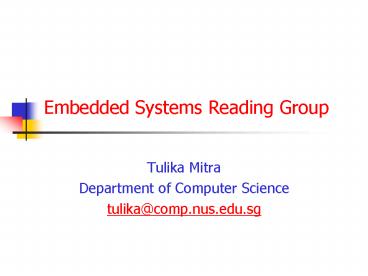Embedded Systems Reading Group - PowerPoint PPT Presentation
Title:
Embedded Systems Reading Group
Description:
To learn the state-of-the-art in embedded systems research ... Not Attainable. Very. Short. Low-Medium. Generic. Long. Long. Long. High. ASIP/ DSP. Impossible ... – PowerPoint PPT presentation
Number of Views:73
Avg rating:3.0/5.0
Title: Embedded Systems Reading Group
1
Embedded Systems Reading Group
- Tulika Mitra
- Department of Computer Science
- tulika_at_comp.nus.edu.sg
2
Motivation
- To learn the state-of-the-art in embedded systems
research - Provide interaction among people interested in
this exciting emerging area - For graduate students
- How to perform effective literature survey
- Presentation skills
- How to participate in small group discussions
3
Computing Systems
- Most of us think of desktop computers
- PC
- Laptop
- Mainframe
- Server
- Maybe at most handheld computer (PDA)
- Now we will look at another type of computing
system which is far more common that you ever
imagined ?
4
Embedded System What ?
- Computing system embedded within electronic
devices - Any device or collection of devices that contain
one of more dedicated computers, microprocessors,
or micro-controllers - Combination of computer hardware and software
designed to perform a specific function - Broad definition Any computing system that is
not a desktop computer
5
Embedded System Examples
6
Embedded System Types
- General purpose computing
- Control systems
- Signal processing
- Communication Networking
7
Embedded System Market
- Average household uses about 225 embedded
processors about 35 for the automobile itself - Estimated 5 billion embedded processor in use ---
94 share of world market Intel Pentium,
Motorola PowerPC, etc. combined is only 6 - source World Semiconductor Trade Statistics
Bluebook
8
Embedded systems characteristics Users
viewpoint
- Single function
- Dedicated to a task or tasks
- Tight constraints
- Size, power, cost, time-to-market
- Real time and reactive
- Respond to environment in real time
- Safety critical
- Failure of hw/sw can be life threatening
9
Embedded systems characteristicsDevelopers
viewpoint
- Concurrent development of hardware and software
hardware/software codesign - Variety of microprocessors
- Variety of operating systems mostly real time
(RTOS) - May not even have any OS services like printf
- Fewer system resources than desktop system
- Requires specialized development tools
- Debugging extremely difficult
- Hardware and software should be extremely robust
10
A typical embedded system
Source Arnold S. Berger
11
Elements of an embedded system
Key Point Although vastly different in
complexity and design, common architectural
traits allow us to design and debug a wide
variety of systems
Source Arnold S. Berger
12
Design Choices
Technology Performance/ Cost Time until running Time to high performance Time to change code functionality
ASIC Very High Very Long Very Long Impossible
FPGA Medium Medium Long Medium
ASIP/ DSP High Long Long Long
Generic Low-Medium Very Short Not Attainable Very Short
Flexibility
Speed
13
Driving Factor
- Moores Law
- Predicted by Intel co-founder Gordon Moore 65
- IC transistor capacity has doubled roughly every
18 months for the past several decades - Process technology can put more and more
functionality on the same chip as CPU at reduced
cost
Source Intel
14
System-on-a-chip (SOC)
- A microprocessor plus additional peripheral
support devices integrated into a single chip - Example Intel StrongARM
Source Intel
15
Liming Factor
- Design productivity gap
- Growing design gap between what technology can
offer and our ability to design in that
technology
Source ITRS99
16
Core based SOC design
- Intellectual Property (IP) circuits or cores are
pre-designed and pre-verified functional units - IP s are reusable implying lower design cost
- Core examples
- Processors ARM, PowerPC, ..
- Memory RAM, memory controller,
- Peripherals PCI, DMA controller,
- Multimedia MPEG/JPEG encoder/decoder
- Digital Signal Processor (DSP)
- Telecommunication Ethernet controller, router,
..
17
Hardware/Software Co-design
- In the past
- Hardware and software design technologies were
very different - At present
- Recently matured synthesis technique enables a
unified view of hardware and software
The choice of hardware versus software for a
particular function is simply a tradeoff among
various design metrics, like performance, power,
size, cost, and especially flexibility there is
no fundamental difference between what hardware
or software can implement.
Source Vahid/Givargis
18
Embedded Systems Faculty
- Tulika Mitra
- Computer architecture, real time systems
- Abhik Roychoudhury
- Modeling, validation of embedded real-time sys
- P. S. Thiagarajan
- Specification, verification, synthesis
- Wong Weng Fai
- Compilers, computer architecture
19
Our research
- Formal specification, verification and synthesis
methods - Compilers and Architectures for Embedded Systems
- Real time systems
- Power Aware Computing
- http//www.comp.nus.edu.sg/embsys
20
Reading group topics
- Case Study
- Specification
- Verification
- Custom processors
- Re-configurable logic
- Design space exploration
- Real time systems
- Low power
- Code compression
- Code generation
- Memory optimization
21
Format
- Each week one of you will be responsible for a
topic or a sub-topic - Please prepare one page summary about the topic
including the references - Presentation can be in any format
- You will lead the discussions through your
presentation - Others should read the references before or after
the presentation (preferably before)































